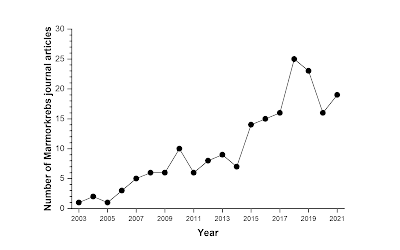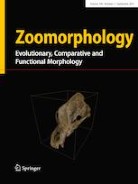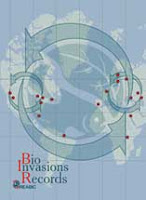An >article about Marmorkrebs by Paul Hetzler is showing up in a wide array of places, from New York state to India. It’s generally accurate, although I have to raise eyebrows as to the description of the origin of Marmorkrebs.
Sometime in the 1990s, a mutant crayfish able to conquer and degrade
aquatic systems emerged as a result of secret German experiments gone
awry. (What the what? - ZF) The marmorkreb (sic), a.k.a. marbled crayfish (Procambarus virginalis),
is a destructive new species that first appeared aquariums in Germany.
However, it’s more likely the result of too much inbreeding in
captivity, rather than some mad-scientist scheme, that led to their
mutation.
I think – I hope – Hetzzler meant the bit about “secret experiments” as a joke. I am willing to be that some people will take it as real and won’t make ti to the second part of the paragraph. But the second part of the paragraph is also pretty dubious.
There is no evidence that inbreeding can cause triploidy. Inbreeding increases homozygosity. It doesn't create extra chromosomes, particularly a whole new set of chromosomes.
By weird coincidence, a technical paper in press also seems to think that just being in captivity is enough to make a species parthenogenetic.
The marbled crayfish Procambarus virginalis probably evolved clonal parthenogenetic reproduction while in the captive aquarium trade. ... With growth in human cultivation of invertebrates for food and other services, the potential for evolution and escape into the wild and subsequent rapid spread of other clonal species is increasing.
This stands in contrast to a recent paper by Gutekunst and colleagues that argues that there are triploid individuals in the natural slough crayfish population, from which Marmorkrebs ultimately emerged.
We need to stop with this narrative that somehow the origin of Marmorkrebs in humans’ fault. It’s not as though there is a shortage of crayfish guilt in the world. It’s our fault we spread them around the globe. That’s on us.
Hetzler also mentions a controversy that... I don’t think exists?
Perhaps the only amusing thing about these nasty aberrations of nature is the mild squabbling as to how one should describe them. Experts disagree on whether the new organisms are mottled, freckled, speckled, spotted, variegated, or something else.
I have never seen a single written comment arguing about what to call the pattern on Marmorkrebs.
Update, 2 December 2021: Yet another article implies that “captivity is to blame for asexual reproduction:
Some insects and other invertebrates have evolved a novel solution to the “can’t get a date” problem: They can reproduce without sex. ... At least one invertebrate, the marbled crayfish, evolved the ability to reproduce asexually in captivity and is now spreading rapidly across Europe, Africa and Asia, carrying with it disease that harms native species. As we cultivate other invertebrates for food or hobbies, we raise the risk that something similar might happen with other species.
I say again: just the act of keeping a species in a tank does not increase the chance of it becoming parthenogentics. It increases the chance we notice it.
Update, 31 December 2021: Even The Guardian gets in on the act by reprinting the Ensia article.
References
Gutekunst J, Maiakovska O, Hanna K, Provataris P, Horn H, Wolf S, Skelton CE, Dorn NJ, Lyko F. 2021. Phylogeographic reconstruction of the marbled crayfish origin. Communications Biology 4(1): 1096. https://doi.org/10.1038/s42003-021-02609-w
Sutherland WJ, Atkinson PW, Butchart SHM, Capaja M, Dicks LV, Fleishman E, Gaston KJ, Hails RS, Hughes AC, Le Anstey B, Le Roux X, Lickorish FA, Maggs L, Noor N, Oldfield TEE, Palardy JE, Peck LS, Pettorelli N, Pretty J, Spalding MD, Tonneijck FH, Truelove G, Watson JEM, Wentworth J, Wilson JD, Thornton A. 2021. A horizon scan of global biological conservation issues for 2022. Trends in Ecology & Evolution: In press. https://doi.org/10.1016/j.tree.2021.10.014
External links
Marbled Crayfish: The Mutants Have Landed
Help keep marbled crayfish from spreading
The Mutants Have Landed
Horizon scan: the opportunities and threats facing Earth’s biodiversity































